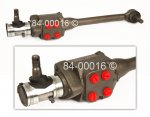Jesus,
If you are absolutely heck-bent on full hydro, but still want fail-proof redundancy, why don't you use concentric cylindrical tubes for the steering shaft from the steering wheel to the gear box.
The inner shaft is separated from the outer shaft by grease-able bearings for smooth operation. It connects directly from your steering wheel to the full hydro system.
The outer shaft is your own custom "rag joint." It connects directly to your stock manual steering box. But instead of only 1/4 inch of play like a normal rag joint, make the outer tube detatched from the steering wheel (inner tube). Have an adjustable tab that allows you to custom set the "play" before the rag joint engages.
That would give you anywhere from 0 to 360 degrees (180 degrees left & 180 degrees right) before the manual steering outer tube had any physical contact with the steering wheel (inner tube).
Any bump-steer in the manual steering caused by suspension flexing would never reach the steering wheel unless it was in excess of 180 degrees ... which is highly unlikely. Therefore, 99.999% of the time the steering would be full hydro.
The other 0.001% of the time you would have the custom rag-joint tab as a redundant, fully manual, just-in-case backup system that would be sufficient from keeping your wheels from locking fully left or right in an emergency. It wouldn't be perfect steering that's for sure. But in the event of a hydraulic failure it would be enough to get you to the side of the road without veering into oncoming traffic.
It could be modified with electric solenoids or clutches (instead of a rag joint) to automatically switch to the full-manual tube in the event of a hydro failure as well. That would be more challenging to do compared to a very loose rag joint, but it would instantly give you 100% manual steering without slop in the event of a failure. A pressure switch activated clutch locks the outer, manual steering tube to the inner, hydro tube in the event of hydro failure. It adds to the complexity, but it would give you 100% hydro & 100% manual in the event of a problem.
And it doesn't matter which is which. You could use the outer tube for hydro & inner tube for manual. It all depends on the connection points for the hydro activators.
The manual steering would not have to be disassembled. Sure it would rotate back & forth during normal hydro use, but who cares? It would be a fail-safe redundant system in case of an emergency.
I say use concentric tubes for the steering column. With proper planning it could give you 100% hydro & 100% manual backup without interference between the two.
That's my









